James Clerk Maxwell proposed electromagnetic waves, which were later confirmed by Heinrich Hertz. Vibrations between an electric and a magnetic field produce electromagnetic waves. In this article, we will look in depth at the definition and formation of electromagnetic waves, as well as their graphical and mathematical representations.
A brief history of electromagnetic waves?
Electromagnetic waves have a long history, dating back to the nineteenth century when scientists first began to understand the relationship between electricity and magnetism.
Hans Christian Oersted, a Danish physicist, discovered in 1820 that an electric current could generate a magnetic field. This discovery prompted additional research by other scientists, including Michael Faraday and James Clerk Maxwell.
Maxwell developed Maxwell’s equations, which describe the behavior of electric and magnetic fields, in the 1860s. These equations predicted the existence of electromagnetic waves by demonstrating that changing electric fields could produce magnetic fields and vice versa.
Heinrich Hertz, a German physicist, conducted experiments to demonstrate the existence of electromagnetic waves in 1887. He demonstrated that radio waves, like light, could be reflected, refracted, and diffracted using an oscillator and a resonant circuit.
Hertz’s experiments laid the groundwork for radio communication, and his discovery of the photoelectric effect aided in the development of quantum mechanics.
Electromagnetic waves have since been studied and used in a variety of applications, including medicine, communication, and scientific research. The discovery and understanding of electromagnetic waves revolutionized our understanding of the natural world and enabled the development of many modern technologies.
What is electromagnetic waves?: Definition
EM waves, short for electromagnetic waves, are a type of energy that travels through space as a combination of electric and magnetic fields. These waves are produced when an electric field interacts with a magnetic field. Simply put, the electric and magnetic fields oscillate together to create an electromagnetic wave.
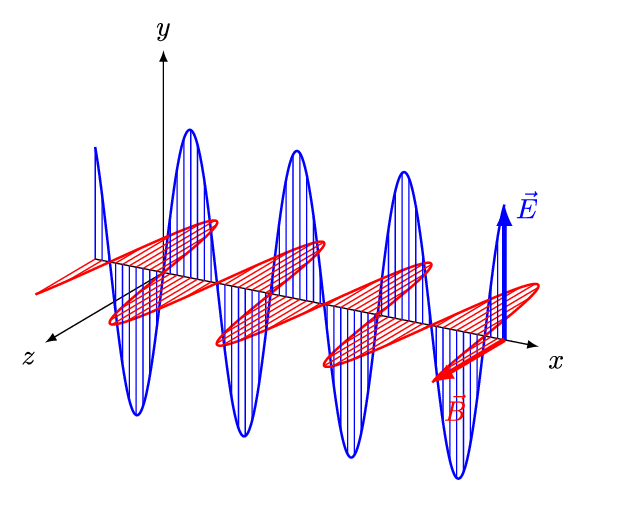
Maxwell’s equations are the fundamental equations that describe how electromagnetic waves behave. Scientists use these equations to understand how electromagnetic waves interact with matter and how they travel through space.
Electromagnetic waves definition: Electromagnetic waves are a type of energy that travels through space in the form of oscillating electric and magnetic fields, and they cover a wide frequency range known as the electromagnetic spectrum. These waves are caused by accelerating electric charges, such as those found in atoms, and they are responsible for a wide range of natural phenomena as well as practical applications in technology.
How are electromagnetic waves produced?
- Electromagnetic waves are formed when an oscillating electric field and an oscillating magnetic field interact with each other.
- These fields are generated by charged particles that are in motion.
- When an electrically charged particle moves, it creates an electric field around itself.
- The electric field can then interact with a magnetic field, which is created by the movement of charged particles in a nearby area.
- The interaction between the electric and magnetic fields generates an electromagnetic wave.
- The frequency of the electromagnetic wave is determined by the frequency of the oscillating electric and magnetic fields.
- Electromagnetic waves can also be produced by accelerating charged particles, such as in the case of radio waves produced by an antenna or X-rays produced by the acceleration of electrons in a particle accelerator.
- Once formed, electromagnetic waves travel through space at the speed of light, and their energy can be detected and utilized in a variety of ways, including in communication, medicine, and scientific research.
Graphical Representation of Electromagnetic Waves
Electromagnetic waves can be represented graphically as a wave with two components, an electric field and a magnetic field, that oscillate perpendicular to each other and to the direction of the wave’s propagation. This representation is known as a transverse wave, meaning that the oscillations of the fields are perpendicular to the direction of wave motion.
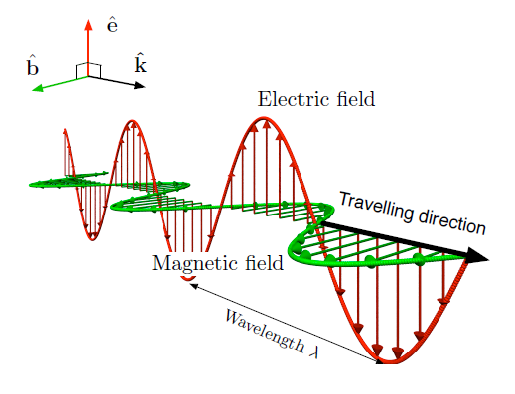
In this representation, the electric field is shown as a wavy line oscillating up and down, while the magnetic field is represented by a line oscillating perpendicular to the electric field. The direction of propagation of the wave is shown as a straight line perpendicular to both the electric and magnetic fields.
The amplitude of the electric and magnetic fields represents the strength of the wave, while the wavelength represents the distance between two consecutive peaks or troughs of the wave.
The electromagnetic spectrum, which includes a range of frequencies of electromagnetic waves, can also be represented graphically as a spectrum with increasing frequency and decreasing wavelength. This spectrum includes radio waves, microwaves, infrared radiation, visible light, ultraviolet radiation, X-rays, and gamma rays. Each type of electromagnetic wave has unique properties and uses, depending on its frequency and energy.
Plane electromagnetic wave equation
The equation for a plane electromagnetic (EM) wave in the vacuum can be expressed mathematically as follows: $$\begin{aligned}E(x, t) &= E_0\sin(kx – \omega t + \phi)\\B(x, t) &= B_0\sin(kx – \omega t + \phi + \pi/2)\end{aligned}$$
where:
- E(x, t) is the electric field at a point x and time t.
- B(x, t) is the magnetic field at the same point and time.
- $E_0$ and $B_0$ are the amplitudes of the electric and magnetic fields, respectively.
- k is the wave number, which is related to the wavelength λ by the equation k = 2π/λ.
- ω is the angular frequency, which is related to the frequency f by the equation ω = 2πf.
- φ is the phase angle, which determines the initial phase of the wave.
This equation represents a sinusoidal wave that propagates in the x direction with a velocity equal to the speed of light in vacuum, c. The electric and magnetic fields are perpendicular to each other and to the direction of propagation.
The direction of propagation of the electromagnetic wave is given by the vector cross-product of the electric field and magnetic field. It is given as $$\overrightarrow{E}\times \overrightarrow{B}$$
The plane EM wave equation describes the simplest form of an EM wave, which is characterized by a constant wavelength and frequency, and a uniform amplitude and phase. In reality, most EM waves are not perfectly plane, and they may have a complex wavefront that varies over time and space.
However, the plane wave equation is useful for understanding the basic properties of EM waves, such as their polarization, direction of propagation, and energy density. It is also used as a starting point for more complex wave equations that describe the behavior of EM waves in different materials and environments.
Electromagnetic wave equation
The electromagnetic wave equation is a partial differential equation of second order that describes the propagation of electromagnetic waves in a medium or in a vacuum. It is a three-dimensional representation of the wave equation. The homogeneous form of the equation, written in terms of either the electric or magnetic fields E or B, is as follows:
where:
is the phase velocity of light in a medium with permeability and permittivity, and 2 is the Laplace operator. A fundamental physical constant is $v_{ph} = c_0 = 299792458 m/s$ in a vacuum. Maxwell’s equations are the basis for the electromagnetic wave equation. In most older works, B is referred to as magnetic flux density or magnetic induction. The equations that follow:

This predicts an electromagnetic wave must be a transverse wave, with the electric field E and the magnetic field B both perpendicular to the direction of wave propagation.
Read Also:
- Transformer – Definition, Types, Working Principle, and Constructions
- LC oscillation class 12
- Expression for energy and average power stored in a pure capacitor
Intensity of electromagnetic waves
The intensity of an electromagnetic (EM) wave is a measure of the energy that is transported by the wave per unit area per unit of time. Mathematically, it can be expressed as:
$$I = \frac{1}{2}\epsilon_0cE^2$$
where:
- I is the intensity of the EM wave in watts per square meter (W/m^2).
- ε0 is the permittivity of free space, which is a constant with a value of approximately 8.85 x 10^-12 F/m.
- c is the speed of light in a vacuum, which is also a constant with a value of approximately 3.00 x 10^8 m/s.
- E is the amplitude of the electric field of the EM wave.
This equation shows that the intensity of an EM wave is proportional to the square of the amplitude of its electric field. It also shows that the intensity depends on the properties of the medium through which the wave is propagating since the permittivity of the medium affects the electric field.
The intensity of an EM wave can also be related to its power, which is the rate at which energy is transported by the wave. If A is the area of a surface that is perpendicular to the direction of propagation of the wave, then the power of the wave can be expressed as:
$$P= IA$$
where P is the power of the wave in watts (W).
The intensity of an EM wave is an important parameter in many applications, such as communications, sensing, and medical imaging. It is also a fundamental concept in the study of optics and electromagnetism.
Speed of electromagnetic waves in free space
The speed of electromagnetic (EM) waves in free space is a fundamental constant of nature, denoted by the letter c. In a vacuum, EM waves travel at the speed of light, which is approximately 299,792,458 meters per second (m/s) or 3.00 x 10^8 m/s.
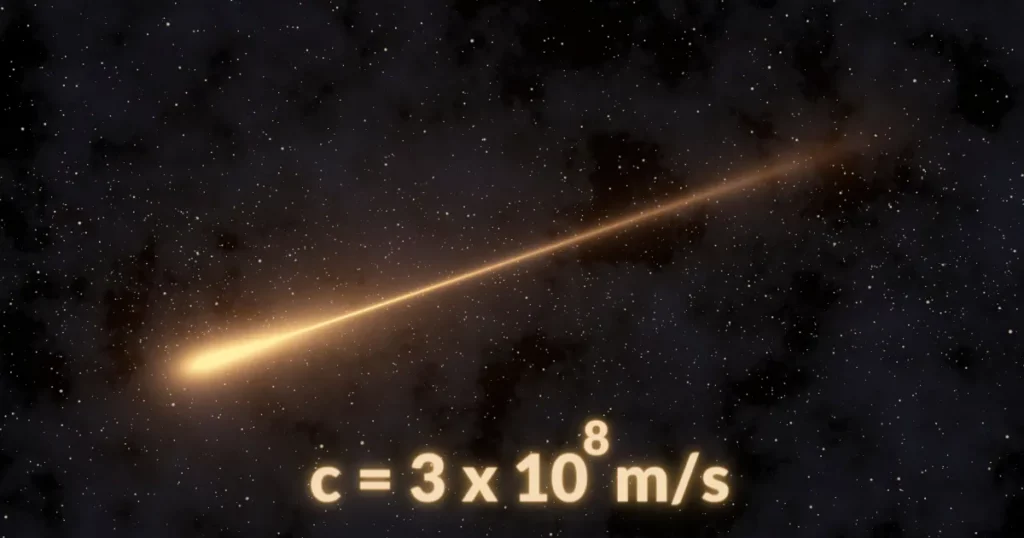
The speed of EM waves is determined by the properties of the medium through which they are propagating. In a vacuum, the permittivity and permeability of the medium are constant, and their product is equal to the inverse square of the speed of light:
$$\epsilon_0\mu_0 = \frac{1}{c^2}$$
where $\epsilon_0$ is the permittivity of free space, $\mu_0$ is the permeability of free space, and $c$ is the speed of light.
This equation shows that the speed of EM waves in free space is determined by the permittivity and permeability of the vacuum, which are fundamental constants of nature. The speed of light in a vacuum is the maximum speed at which information or energy can be transmitted through the universe.
The speed of EM waves in materials other than vacuum depends on the permittivity and permeability of the medium, which can be different from those of free space. In general, the speed of EM waves in a medium is slower than the speed of light in a vacuum.
The relationship between the speed of EM waves and the properties of the medium is described by the refractive index, which is a dimensionless quantity that relates the speed of light in a vacuum to the speed of light in the medium.
Electromagnetic spectrum class 12
The electromagnetic (EM) spectrum is the range of all types of electromagnetic radiation. It includes various types of waves that differ in their wavelengths and frequencies. The EM spectrum is divided into several regions, each with its own characteristics and applications. Here are the regions of the EM spectrum, in order of increasing frequency and decreasing wavelength:

- Radio waves: Radio waves have the longest wavelengths and the lowest frequencies in the EM spectrum. They are used in communication and broadcasting, such as AM and FM radio, television, and mobile phones.
- Microwaves: Microwaves have shorter wavelengths and higher frequencies than radio waves. They are used in communication, radar, and heating applications, such as microwave ovens.
- Infrared radiation: Infrared radiation has wavelengths shorter than microwaves and longer than visible light. It is emitted by warm objects and is used in thermal imaging and remote sensing applications.
- Visible light: Visible light has wavelengths that range from about 400 to 700 nanometers and frequencies that are higher than infrared radiation. It is the only region of the EM spectrum that can be detected by the human eye and is responsible for our sense of vision.
- Ultraviolet radiation: Ultraviolet (UV) radiation has wavelengths shorter than visible light and higher frequencies. It is emitted by the sun and is responsible for sunburns and skin damage. UV radiation is also used in sterilization and fluorescence applications.
- X-rays: X-rays have even shorter wavelengths and higher frequencies than UV radiation. They are used in medical imaging, such as X-ray machines and CT scans.
- Gamma rays: Gamma rays have the shortest wavelengths and highest frequencies in the EM spectrum. They are emitted by radioactive materials and are used in cancer treatment and nuclear medicine.
Each region of the EM spectrum has different properties and applications, and together they provide a powerful tool for exploring the universe and improving our daily lives.
Read Also:
- Expression for energy and average power stored in an inductor
- Grouping of inductors | inductors in series & parallel, class 12
- Derivation for mutual inductance of two long co-axial solenoids
Properties of electromagnetic waves class 12
Electromagnetic waves are a type of transverse wave that consists of oscillating electric and magnetic fields. They have several properties that distinguish them from other types of waves. Some important properties of electromagnetic waves are given below:
- Electromagnetic waves travel at the speed of light: This is a fundamental property of electromagnetic waves, and it is the reason why light can travel through a vacuum.
- Electromagnetic waves are transverse waves: This means that the oscillations of the electric and magnetic fields are perpendicular to the direction of propagation of the wave.
- Electromagnetic waves have a wavelength and frequency: The wavelength is the distance between two consecutive crests or troughs of the wave, while the frequency is the number of crests or troughs that pass a point in one second.
- Electromagnetic waves have a range of frequencies: This range is known as the electromagnetic spectrum and includes radio waves, microwaves, infrared radiation, visible light, ultraviolet radiation, X-rays, and gamma rays.
- Electromagnetic waves do not require a medium to travel through: Unlike sound waves, which require a medium such as air or water to propagate, electromagnetic waves can travel through a vacuum.
- Electromagnetic waves can be polarized: This means that the oscillations of the electric and magnetic fields can be restricted to a particular plane, which can be used to filter or block the wave.
- Electromagnetic waves can be reflected, refracted, and diffracted: Just like other types of waves, electromagnetic waves can be reflected off of surfaces, refracted when passing through a medium with a different refractive index, and diffracted when they encounter an obstacle or opening.
Applications of electromagnetic waves
Electromagnetic waves have a wide range of applications in many fields, including:
- Communication: Electromagnetic waves are used in radio, television, and cellular communication to transmit information over long distances. The waves are modulated to carry signals that can be decoded by receivers.
- Medicine: Electromagnetic waves are used in medical imaging techniques such as X-rays, CT scans, MRI scans, and PET scans. The waves are used to visualize the inside of the body and diagnose medical conditions.
- Astronomy: Electromagnetic waves are used to study the universe through telescopes that detect visible light, radio waves, and other forms of electromagnetic radiation.
- Microwave ovens: Electromagnetic waves with a frequency of 2.45 GHz are used in microwave ovens to heat food by exciting the water molecules in the food.
- Remote sensing: Electromagnetic waves are used in remote sensing applications to measure the properties of the Earth’s surface and atmosphere. Satellites and airplanes equipped with remote sensing instruments detect and analyze the waves reflected or emitted by the Earth’s surface.
- Radar: Electromagnetic waves are used in radar systems to detect the location, speed, and direction of moving objects such as aircraft, ships, and weather patterns.
- Security systems: Electromagnetic waves are used in security systems such as metal detectors and body scanners to detect hidden objects or weapons.
- Entertainment: Electromagnetic waves are used in entertainment systems such as television and radio broadcasting, as well as in music and sound systems.
- Manufacturing: Electromagnetic waves are used in industrial processes such as welding, heating, and drying.
- Energy: Electromagnetic waves are used in renewable energy technologies such as solar panels and wind turbines to convert electromagnetic energy into electrical energy
Frequently Asked Questions – FAQs
Why is it called electromagnetic waves?
Electromagnetic waves are so-called because they are made up of oscillating electric and magnetic fields that are coupled and propagate through space together.
This coupling of electric and magnetic fields is referred to as electromagnetic radiation, hence the term “electromagnetic waves.” These waves were predicted in the 1860s by James Clerk Maxwell and later confirmed by experimental observations, leading to the development of electromagnetism theory.
Who discovered electromagnetic waves?
The discovery of electromagnetic waves is usually attributed to James Clerk Maxwell, a Scottish physicist and mathematician, who developed a set of equations describing the behavior of electric and magnetic fields.
In the 1860s, Maxwell realized that his equations predicted the existence of electromagnetic waves, which would propagate through space at the speed of light. He showed that these waves would have the same properties as light and would thus be a form of electromagnetic radiation. Maxwell’s predictions were later confirmed by experimental observations, most notably by the work of Heinrich Hertz in the late 19th century.
How do electromagnetic waves travel?
Electromagnetic waves travel through space as a combination of oscillating electric and magnetic fields that are perpendicular to each other and to the direction of wave propagation. Because waves do not require a medium to travel through, they can travel through a vacuum.
The wave’s electric and magnetic fields are self-sustaining and constantly regenerate each other as it moves. Electromagnetic waves travel at the speed of light (299,792,458 metres per second) and can be generated by a variety of sources, including oscillating charges, moving charges, and accelerating charges.
What is electromagnetic theory?
Electromagnetic theory is a branch of physics that studies how electric and magnetic fields behave and interact with matter and each other. It is based on the concept of electromagnetic radiation, which refers to the speed of light propagation of oscillating electric and magnetic fields through space.
Several scientists, including Michael Faraday, James Clerk Maxwell, and Heinrich Hertz, contributed to the theory. The theory explains how electromagnetic waves are created, interact with matter, and are detected and measured. Electromagnetic theory has numerous technological applications, including communication, energy generation, medical imaging, and many more.
Can electromagnetic waves carry electricity?
Electromagnetic waves can cause electricity to flow in a conductor, but they do not carry electricity themselves. When an electromagnetic wave interacts with a conductor, an oscillating electric field is created, which can cause the electrons in the conductor to move back and forth. This movement of electrons causes an electric current to flow.
This phenomenon underpins the use of electromagnetic waves for wireless communication and power transfer. Radio waves, microwaves, and other types of electromagnetic waves, for example, can be used to carry signals for wireless communication and to transfer power over short distances. It is important to note that electromagnetic waves are not made up of electric charge carriers and thus do not carry electric charge in the same way that a conventional electric current in a wire does.
Stay tuned with Laws Of Nature for more useful and interesting content.




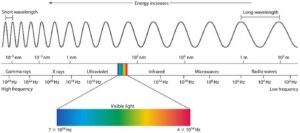
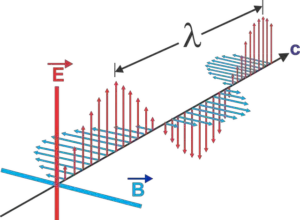

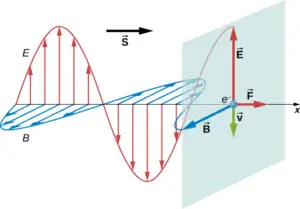
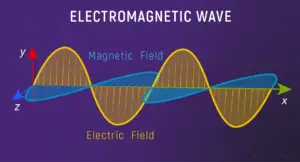
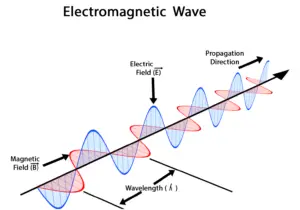
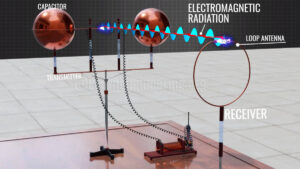
Very well explained article 👍. It helps me a lot. Thanks for this article.